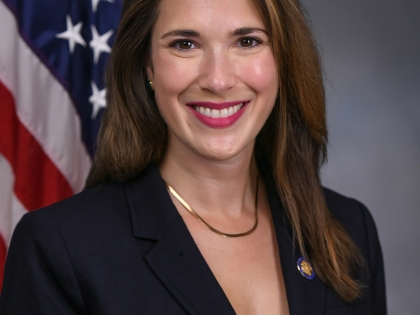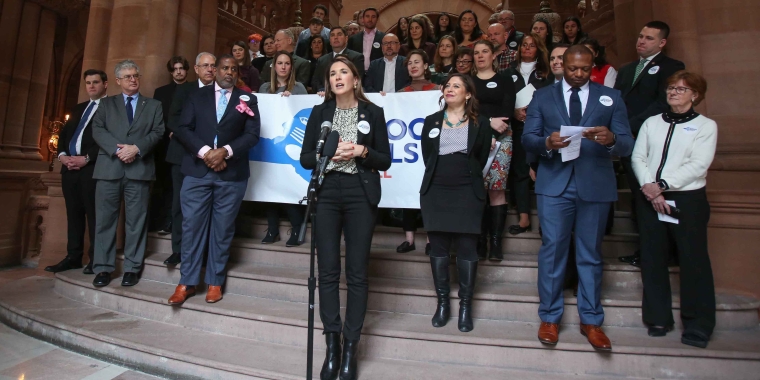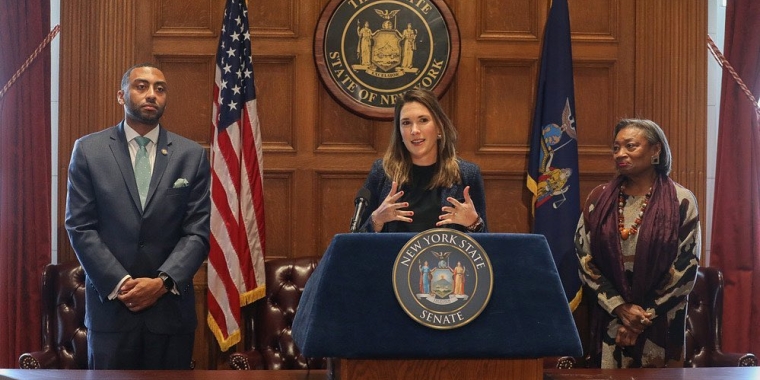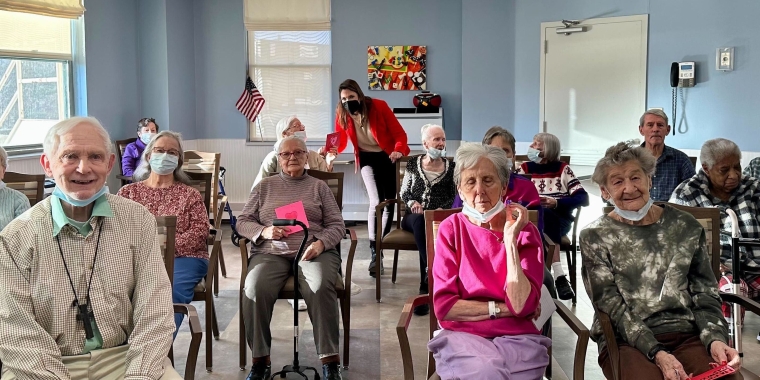
Two Hinchey Bills to Strengthen EMS and Expand Emergency Care Signed into Law
September 18, 2024

ALBANY, NY – Senator Michelle Hinchey announced that two of her bills to improve emergency care and support EMS providers statewide have been signed into law, including legislation creating three new reimbursement sources for EMS (S8486C) and expanding the ability of motor vehicle ambulance services to administer life-saving blood transfusions (S6226A).
Previously, EMS was only reimbursed for transporting patients to hospital ERs. Senator Hinchey’s bill, S8486C, expands this to include reimbursement for on-scene treatment, transport to approved healthcare facilities like urgent care and mental health clinics, and telemedicine consultations. This change, effective October 1, 2024, comes on the heels of a rally led by Hinchey, EMS, and Fire leaders urging for the signing of this bill. A second Hinchey bill, S6226A, allows ambulances to carry and transfuse blood during all emergency transports, not just between hospitals. Under the former system, ambulances could only handle blood during inter-hospital transfers, but this bill removes those restrictions, expanding assistance for all trauma patients.
Senator Michelle Hinchey said, “I’m incredibly proud that two of my bills to immediately strengthen EMS and help save lives in our communities have been signed into law. Our legislation will finally ensure EMS get paid for care they’re not currently reimbursed for, like on-site treatment, telemedicine, and specialized transport to mental health facilities, as well as allow ground ambulances to administer life-saving blood transfusions to trauma patients in all emergency situations, not just between hospitals. EMS is a pillar of our healthcare system, especially in rural and medically underserved areas where EMS is the first – and at times the only – line of emergency care. These bills being signed into law are a critical win at a time when EMS providers need our support more than ever to stay open and available for the rural communities that need their life-saving services.”
Assemblymember Anna Kelles said, “Emergency Medical Services provide essential lifesaving care throughout the state, including direct aid both on site and in transit to a medical facility. These services are especially critical in rural areas where access to hospitals may be hours away. I am grateful to Governor Hochul for signing this bill today and taking a large step towards reimbursing these brave, dedicated healthcare providers. Providing them with discretion to determine the emergency location that will best serve their patient’s needs not only is common sense, but it also provides a more efficient delivery of emergency services.”
“By signing these pieces of legislation into law, Governor Hochul is giving New York’s EMS providers and professionals a booster shot in the arm, providing more flexibility and funding to do what they do best: save lives,” said NYSAC President Benjamin Boykin II. “EMS providers are struggling to pay their bills amid rising costs, high demand for increasingly complex services, and outdated Medicaid requirements that only reimburse EMS providers when they transport a patient to a hospital. Under the new Treatment in Place law, EMS providers can provide patients with the care they need at the scene, or transport them to more appropriate locations like mental health clinics, substance abuse facilities, or urgent care, without being financially penalized. Counties commend Governor Hochul, Senator Hinchey and Assemblymembers Kelles and Woerner for their leadership and commitment to strengthening EMS in New York State.”
Aidan O’Connor Jr, Executive Director of Greenport Rescue Squad Inc. in Columbia County and previous EMS Coordinator for Greene County, said, “The treat-in-place and alternative destinations bill is transformational for all EMS—whether municipal, non-profit, commercial, rural, suburban, or urban. The blood transfusion bill for ground ambulances provides one of the most vital tools in our toolbox to save lives and represents the most advanced contribution to EMS in New York State in decades. In a time when EMS is in crisis, these measures will make a significant positive impact on our patients, providers, and communities.”
Timothy P. Egan, Chairperson of the United New York Ambulance Network (UNYAN), Executive Director of Rockland Paramedic Services, and CEO of Rockland Mobile Care, said, “On behalf of our members who provide vital ambulance services for the entire state, I thank Governor Kathy Hochul for signing these two crucial bills into law. The TIP/TAD law will ensure ambulance service providers are reimbursed for the care they provide to every Medicaid patient in every scenario, boosting EMS and the overall healthcare system. The ground ambulance blood transfusion law will significantly improve patient outcomes and survival rates of traumatically injured patients across New York State. We are deeply grateful to Governor Hochul and the entire legislature, notably Senator Michelle Hinchey, for recognizing the importance of these two bills and making them a reality.”
NYS Volunteer Ambulance and Rescue Association (NYSVARA) President Henry Ehrhardt said, “The New York State Volunteer Ambulance and Rescue Association is grateful to Governor Hochul and the New York State Legislature for enacting these new laws that will improve emergency medical services throughout New York State. The Treat-In-Place law will allow Medicaid to provide payment to EMS services when they provide patient-centered care without ambulance transportation to the hospital emergency room. The ground ambulance blood transfusion law will bring lifesaving care to patients with serious injuries. Both new laws demonstrate New York’s commitment to innovation and quality in emergency medical services. EMTs and Paramedics are the first health professionals that people see when they are ill and injured. These new laws give EMS clinicians more tools to care for their communities. We are grateful to the Governor and Legislature for their multi-year commitment to improvements and investments in emergency medical service.”
"In addition to responding to fires and other emergencies, volunteer departments across New York are also a big part of the provision of the state's vital Emergency Medical Services," said Firefighters Association of the State of New York President Eugene Perry. "The enactment of these new laws, which give more decision-making authority to first responders on scene, marks another step forward in improving our emergency response capabilities. FASNY applauds the Governor for signing this important bill and for her continued attention on the first line of healthcare in NYS. The Association also remains appreciative of Senator Hinchey’s continued leadership on issues facing first responders in concert with her legislative colleagues. Our shared work continues as we forge ahead with measures to further strengthen EMS in New York State, most notably through better incentives to attract recruits and retain the force we have.”
Donald Corkery, President of the Association of Fire Districts of the State of New York, said, “We commend Governor Hochul for enacting these crucial bills into law and extend our gratitude to Senator Michelle Hinchey, Assemblywoman Anna Kelles, and Assemblywoman Carrie Woerner for successfully guiding these bills through the Legislature. These bills highlight the essential role of our EMS partners, who are the first to provide care in emergencies. By enabling EMS teams to deliver the most efficient patient care in the most suitable settings, we can ensure faster treatment and better outcomes. Additionally, permitting ambulance services and advanced life support first responders to store, distribute, and administer blood transfusions offers a vital new service option for patient care.”
George June, EMS Director of the NYS Association of Fire Chiefs, said, “We applaud Governor Hochul, Senator Hinchey, Assemblywoman Kelles, and Assemblywoman Woerner for recognizing the importance of equipping EMS workers with the necessary tools to deliver efficient and effective care. Currently, EMS agencies can only receive Medicaid reimbursement when they transport Medicaid patients to a hospital emergency room, even if a hospital isn’t the most suitable place for treatment. This new law will provide essential funding to EMS agencies and ensure that emergency patients are taken to the most appropriate location, which may not always be a hospital. This new law is crucial for funding for EMS agencies, reducing the burden on hospitals as the first point of care for every emergency, and speeding up treatment for patients that don’t need hospital admission. Allowing EMS practitioners to treat patients at their home or at the scene and receive reimbursement for these services enables them to return to work immediately, rather than waiting for hospital admission. Additionally, allowing ambulance services and advanced life support first responders to store, distribute, and administer blood transfusions introduces a vital new option for patient care.”
During the 2024 State Legislative Session, Hinchey garnered broad bipartisan support for both pieces of legislation, which passed the Senate and Assembly unanimously. The coalition supporting S8486C-Hinchey for EMS reimbursement includes the United New York Ambulance Network (UNYAN), NYS Volunteer Ambulance and Rescue Association (NYSVARA), Firefighters Association of the State of New York (FASNY), NYS Association of Fire Districts, NYS Association of Fire Chiefs, NYS Association of Counties (NYSAC), NYS County Executives Association, NYS Association of County Health Officials, EMS Sustainability Alliance, the International Association of EMTs & Paramedics, along with local members of Valatie Rescue Squad, Chatham Rescue Squad, Catskill Ambulance, Hunter EMS, Greenville EMS, and Cairo-Durham EMS. The coalition supporting S6226A-Hinchey for expanded ground ambulance blood transfusions includes the New York American College of Emergency Physicians (NYACEP), NYS Council of Emergency Nurses, NYS Volunteer Ambulance and Rescue Association (NYSVARA), United New York Ambulance Network (UNYAN), and the NYS Professional Firefighters Association (NYSPFFA).
###
Share this Article or Press Release
Newsroom
Go to NewsroomHinchey Leads Push for Universal School Meals
March 1, 2023



Hinchey Statement on Central Hudson CEO Replacement
February 13, 2023
